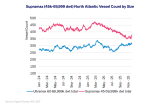
A strong, but not a complete, recovery in hydro generation.
Severe drought conditions in central and coastal China during the first half of 2023 curtailed Chinese hydro generation last spring and contributed to the sharp increase in thermal coal imports in SE China. At the national level, 2Q23 hydro generation fell 30%, mainly in the key hydro-producing provinces and SE China.

Without being able to source 2Q23 hydroelectricity from the key SW China hydro-producing regions, SE China needed alternatives. This included its own nuclear, wind and solar generation, up 7%, 25% and 41% yoy respectively. However, these sources are capacity constrained and additional electricity was sourced from the region’s thermal power plants. Thermal generation, which is mainly coal-fired, increased 28% yoy in 2Q23 and accounted for nearly 80% of SE China power generation. The associated coal requirement was partly sourced from overseas sources and contributed to the staggering 90% growth in Chinese 2Q23 thermal coal imports.
This year, however, the drought has broken.

Chinese hydro generation increased 38% in 2Q24 and 46% in June. In the key hydro-producing regions, which account for ~70% of Chinese production and includes the famed Three Gorges Dam, June hydro generation was up 49%. In SE China hydro generation is smaller and only accounts for 15% of national generation but was up over 70% in June.
Meanwhile, although nuclear generation has been steady, wind and solar generation have soared over 20% this June. The net result has been lower thermal generation. Chinese thermal generation was down 7% yoy in June, but nearly all of this decline took place in SE China where it fell 17%.
There are good reasons to expect hydro generation to continue its recovery over the summer and remainder of 2024. As it stands hydro generation remains slightly below equivalent 2021 and 2022 levels, despite recent capacity growth (eg, Beihetan Dam). Despite the stronger generation, the Yangtze River projects have still filled at record rates – forcing official to spill excess water in mid-July. Both suggest even stronger hydro generation, and continued thermal generation displacement, when it peaks seasonally in July/August.

From a shipping perspective, the question is, to what extent will the recovery in Chinese hydro generation impede thermal coal imports, potentially slowing or reversing some of last year’s growth?
Based on ship tracking data, SE China thermal coal imports soared 46% last year, or an additional 85 Mt. Indonesia and Australia each accounted for roughly 40% of this increase with Australian imports recovering from the 2021-22 import ban. In the first six months of 2024 SE China thermal coal import growth has slowed to +12%, or 16mt, with two-thirds of the incremental coal sourced from Australia. Ominously, Australian and ‘other’ imports turned negative year-on-year in June and (estimated) July, though imports of Indonesian coal remain robust.
While there are other important drivers of import activity, notably increases in industrial demand and higher stockpiling targets, the continued recovery in Chinese hydro suggests slower, and potentially negative, thermal coal import growth over the balance of the year.
By Alastair Stevenson, Head of Digital Analyics, Digital Analytics.
Articles
You may also be
interested in
View allGet in touch
Contact us today to find out how our expert team can support your business














